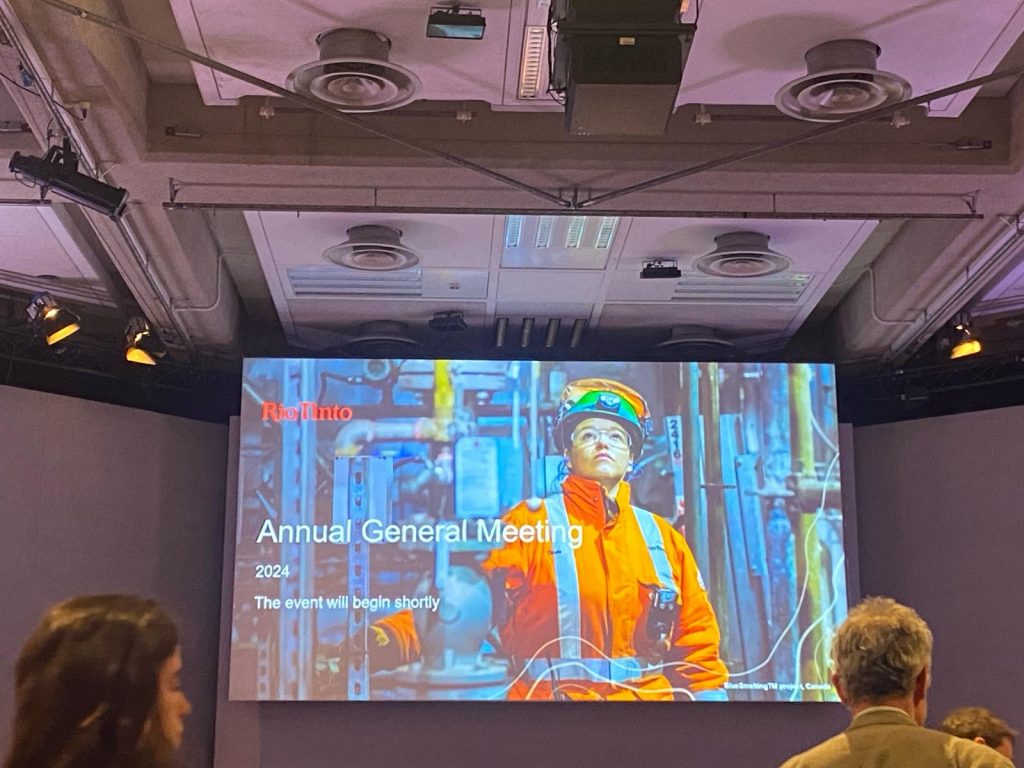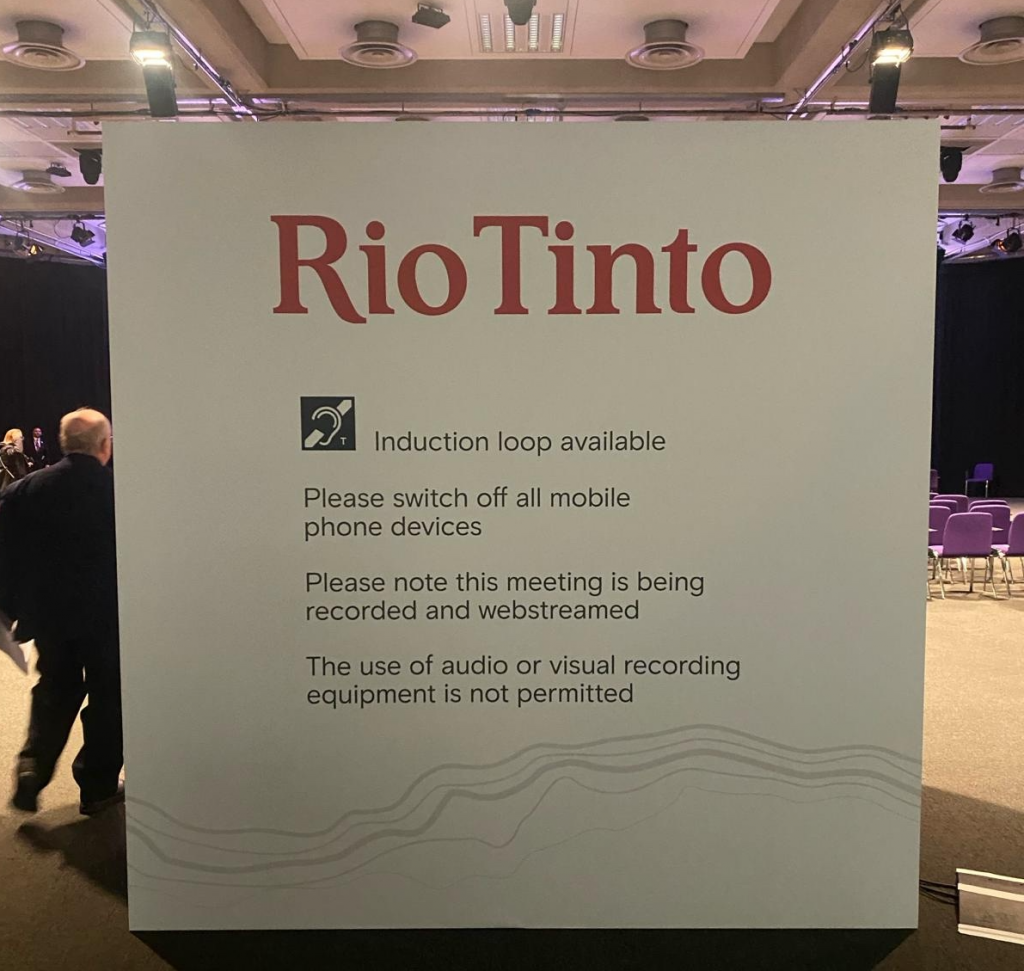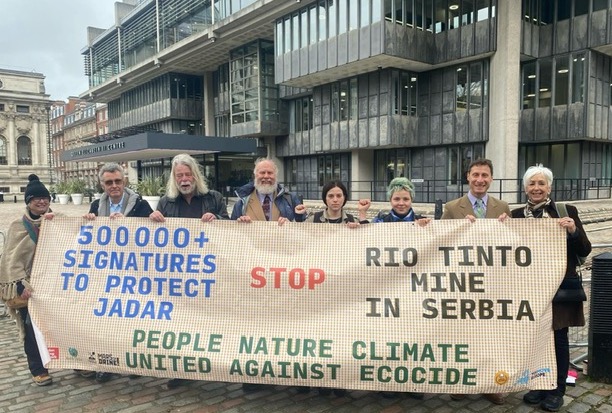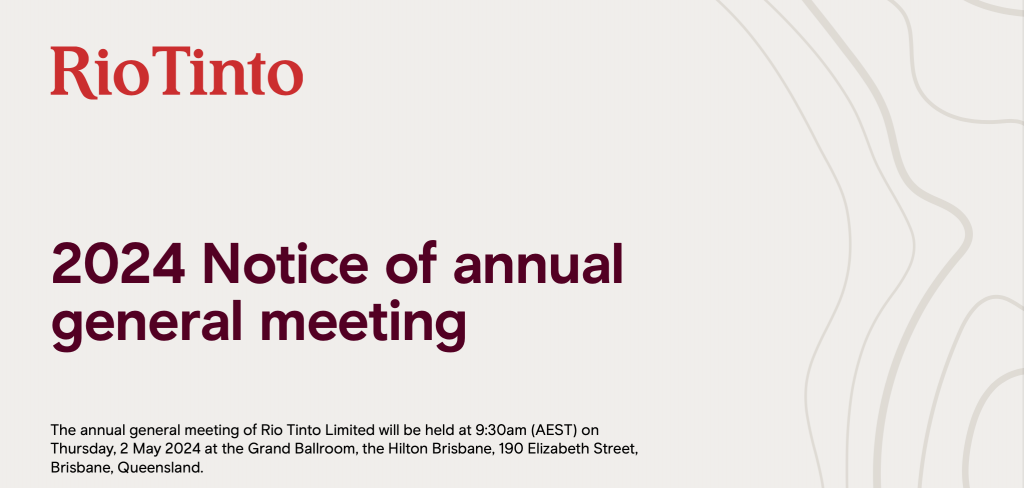
Andrew Lees Trust’s Director attended the Rio Tinto AGM in London, in person on 4th April and online for the Australia AGM on the 2nd May. The aim was to bring questions to the Board and increase transparency and accountability around the impact of the QMM mine’s contamination of local waterways in S Madagascar.
Opening her address to the Board at the London AGM, the Director of the Andrew Lees Trust (ALT UK) took a moment to mark the deaths of three Antanosy citizens who were shot down in what appear to be extrajudicial killings by state police in October 2023. The citizens were demonstrating about arrest warrants still hanging over community leaders who organised protests against QMM in the previous June. There has been repeat conflict around QMM in the last few years.
The AGM questions she brought to the Board of Rio Tinto concerned QMM water contamination. In particular the question of why the company had done nothing to address elevated levels of uranium and lead downstream of the mine, which have been brought to the attention of Rio Tinto since 2019 (Swanson 2019; Emerman 2019) and were now the subject of a legal action. This legal action was announced via an article in The Guardian newspaper on the day of the AGM, she explained.
The Guardian article can be accessed HERE
The Guardian piece, which was an excerpt from an original article in The Intercept published on the 3rd April, brought to light that UK human rights law firm, Leigh Day, are now acting for villagers affected by the QMM mine.
The Intercept article can be accessed HERE
The ALT UK Director went on to explain that the Leigh Day announced that test results from a cohort of villagers living downstream of the mine revealed elevated Blood Lead Levels (BLL) of concern, beyond WHO thresholds, therefore requiring medical attention. Lead toxicity can be especially harmful to children’s development and can cause brain damage. The affected community members are bringing the law suit against the company for damages to their health and environment and to ensure the necessary medical and remedial actions can be taken.

The BLL findings confirm the need to investigate in more depth QMM’s impact on the environment and the health of some 15,000 local people living around the mine, the majority of whom are dependent on natural water sources for drinking and domestic water, also for food, fishing and livelihoods. Communities have been complaining about water quality and QMM impact over many years (Timeline of events at QMM here)
The ALT UK Director said that recent reports published by Rio Tinto from JBS&G 2023 and QMM 2023, on radioactivity and water respectively, continue to claim there is no impact from the mine. However, recent analyses of these studies /reports from expert hydrologist Dr Emerman and radioactivity specialist Dr Swanson, challenge and contradict this narrative.
Summary points were shared at the AGM, highlighting the problems arising from unsupported conclusions in the JBS&G study through to data management issues in the QMM 2023 water report.
Expert analyses on QMM reporting can be accessed HERE
One important factor in water analysis has been the introduction of pre-mining data into Dr Emerman’s analysis of QMM’s water reporting. This data took four years to access from QMM. It provides important readings of uranium and lead pre-mining and, using all available water data, demonstrates the increase in uranium concentration by a factor of 884 from before to after opening the mine was statistically significant at the 99.999999999% confidence level. As yet, QMM have not incorporated or applied its own baseline water data to measure the comparison of pre to post mining water quality.
Given all the concerns, the Board were asked to explain why Rio Tinto persists in refusing Malagasy civil society requests for independent audits – specifically an independent water impact assessment as previously requested at last year’s AGM.
Investors have also been asking the company to commit to independent water impact assessments, as Reuters reported earlier this year. The Local Authorities Pension Fund Forum (LAPFF) raised the question of independent water impact assessments again at this year’s AGM.
A full recording if the AGM can he accessed HERE (Questions raised on QMM and the response can be heard at 1.16.53 –and closing comment 2.16.24)
Rio Tinto did not answer the questions raised by ALT UK at the AGM about the need for independent water impact assessment at QMM. Instead, they quoted the latest QMM water report 2023, stating there were no uranium and lead levels of note. They typically ignored the data problems raised about the QMM report and the JBS&G study.
In the first part of his response, the Chair of the Rio Tinto Board claimed that the death of three protestor in October 2023 were related to conflict around elections. This was not the case. The deaths, that appear to be extrajudicial killings by state police, took place when a local association’s members gathered on private ground adjacent to the road that goes to the mine. They were protesting that their two leaders were still under arrest warrants for organising protests against QMM in June 2023. Despite verbal promises of clemency, no official release from the warrants had been forthcoming.
There has been no inquiry about the killings, and no closure for bereaved families. QMM has security arrangements with local police and army, and the Chair’s framing of the protests highlights how QMM protests have been increasingly politicised by the state and by the company.
Access more information about the conflict around QMM HERE
The Chair of the Board said the company cared deeply about the water quality and what was happening at QMM and encouraged “viewpoints from different groups”. However, ALT UK was deliberately excluded and refused attendance at a stakeholder meeting organised by Rio Tinto in March this year about QMM water quality. A number of the NGOs who attended commented upon and criticised the exclusion, cognisant that ALT UK brings research and expert analysis, which contributes vital information to these discussions.
The Chair invited the CEO of Minerals to comment on water issues. She explained that new QMM water report 2021-2023 had been simplified according to requests from local people. It is not clear who has made these requests and they do not reflect requests from Malagasy civil society e.g., PWYP MG and internationals e.g., ALT UK who have repeatedly asked the company to ensure raw data sets be included in any QMM water reporting to ensure open access – specifically for independent analysis of the raw data. The company did not do this.
It took three months after the report was issued to obtain the raw data sets. These appeared to represent different data (the raw data numbers) to that which was presented graphically (as a visual) in the QMM report. The problem of the two sets of QMM water data for 2021-2023 that do not match each other, without any clarity on which is the correct set of data, was ignored and not addressed by Rio Tinto in their response.
The company also did not mention that the QMM 2021-2023 water report only looks at a subset of water data (21 months) and does not include previous data, nor the pre-mining (baseline) data and so is not representative of the overall water quality situation. The detrimental impact of the mine continues to be indicated when using all available data.
The CEO of Minerals also explained that withholding the WRG report on fish deaths of 2022, following two dam failings and the release of a million cubic metres of mine basin water, was because the results were “inconclusive”. The company has also stated that they are concerned that local people will misinterpret the results. Neither of these are valid or acceptable reasons to withhold a promised report and data.
The company has repeatedly claimed QMM was not responsible for the fish deaths in 2022. So, it seems that when the WRG study results do not support QMM’s position conclusively, the report is then deliberately withheld – an action which raises profound questions and concerns. The WRG report and data, which was requested and promised to civil society and investors alike for almost two years, must be shared. It should be included in and contribute to the wider body of available data and knowledge about the QMM mine impacts.
The AGM was covered by Reuters who mention the Madagascar water issues, see HERE

Water was a theme carried through multiple questions and interventions at the AGM by representatives from Serbia, Mongolia, Arizona, and Guinea. Together with Madagascar and Bougainville, water issues have been identified and collectively published in a six country Briefing about Rio Tinto mines in these countries, all of which face issues with water contamination, water access and or mine tailings management.
See LMN’s report of the London 2024 AGM coverage HERE
London Mining Network (LMN) convened various group activities and meetings around the AGM this year and amplified the call for attention on water issues and the need for independent water impact assessments for existing and proposed mines. As the energy transition demands exponential mineral extraction, and the mining industry uses vast quantities of water, frequently discharging contaminants in its wake, the question of rights of use, access and management of water quality is a globally significant and pressing issue.
At the Australia AGM, the Chair of the Board emphasised that Rio Tinto published its water data and was one of the first companies to do so. However, this reporting has concerned water usage and not water quality. As shown above (in the six country briefing) multiple countries that host Rio Tinto mines are experiencing problems with water contamination issues, or threats of similar for proposed mines, and lack of transparency over water and related mine tailings management.

On May 2nd Rio Tinto’s Australia AGM was held in Brisbane. Thanks to the Australasia Centre for Corporate Accountability, the Director of ALT UK was able to attend by proxy via an online link.
At this second AGM, in answer to ALT UK’s questions about QMM water contamination, the Blood Lead Levels from testing and the launch of a legal case, the Chair of the Board reiterated the care Rio Tinto has about the water quality and then asked the CEO of Minerals to comment. She listed all the studies that Rio Tinto have commissioned and produced about QMM. In this regard the company response was not substantially different to what had been said in London, and equally bypassed the critiques of the recent QMM studies that new experts’ analyses have provided ( see above).
Once again, the company used its own studies to claim transparency and ignored the calls for an independent water impact assessment that Malagasy civil society, with support from ALT UK, have been demanding.
The Board of Rio Tinto completely ignored the question and request for audits of QMM human rights policies and practices and its grievance and compensation procedures, all of which have been the subject of multiple complaints.
The Australia AGM can be heard in full HERE and the questions on QMM can be heard at 57.16 in the recording
In the response, the CEO of Minerals mentioned the Trust’s intervention at the 2017 Rio Tinto AGM and suggested the company then started investigating radiological issues. That is not the case. In fact it was the Trust that commissioned an independent radioactivity study at that time and the ensuing report by Swanson (2019) published the finding of elevated uranium downstream of QMM, 50 times higher than WHO safe drinking water guidelines (using QMM water data). As the majority of communities living around the mine draw their drinking water from lakes and rivers downstream of the mine this finding was of particular concern.
The company’s initial response to the finding by Swanson was to ask the Trust to remove the high uranium finding from the Swanson report. ALT UK declined. The Swanson study also highlighted that QMM had inadequate monitoring of the wider environment around QMM, in particular to understand the mine’s impact and contribution to incremental radiation exposure, and QMM been not been carrying out any monitoring of ingestion pathways around the QMM mine. The company then commissioned the 2019 JBS&G study, which was finally published at the end of last year.
Swanson’s recent analysis of the JBS&G 2023 report, while commending improvements in radioactivity monitoring at QMM brought about by JBS&G, has concluded that “The level of confidence in the conclusions presented in the (JBS&G) report cannot be determined quantitatively because of limitations of the study design.” Guidance for Data Quality Objectives was not consistently nor completely followed. The data do not support the primary argument in the JBS&G report regarding incremental contribution of the mine to radiation dose (P3 Swanson, 2024). In other words the company’s claims that there is no radiological impact and no health impact cannot be supported.
ALT UK’s Briefing on QMM 2024 can be found HERE
The Australia AGM provided an opportunity to alert investors in Australia to issues at the QMM mine that they may not otherwise hear about. ALT UK’s questions informed those present about the legal case by Leigh Day, the testing and identification of elevated Blood Lead Levels in villagers living downstream of the QMM mine, and they were pointed to where they could access expert analysis of the current studies produced by QMM, which challenge and contradict the claims being made by the company.
Protracted dialogue on QMM since 2017
There are too many questions arising around QMM operations to raise at any single AGM. The company is failing in its dialogue and not addressing all the issues raised, especially around detailed technical questions. For example, after two years from pilot to expansion of its new water treatment plant, QMM cannot explicitly state all the contaminants that are in or how it will manage the toxic waste product from the process. The toxic waste is being stored in “geotextile bags” on site but the company admits there is no capacity for Madagascar to handle this waste product.
Most recently Rio Tinto has started the practice of directing ALT UK and its questions towards a third-party platform that does not yet exist, and in which ALT UK has not agreed to participate.
ALT UK has been in direct dialogue with Rio Tinto since 2017 when it raised the QMM breach of an environmental buffer zone at the company 2017 AGM and concomitant questions about water contamination. ALT UK has worked closely with community representatives and Malagasy civil society actors, especially Publish What You Pay Madagascar (PWYP MG) with whom it collaborates closely on research and advocacy actions, to help amplify communities’ rights. Specifically to protect their and future generations’ right to a clean, healthy and sustainable environment.
ALT UK continues to support the call for independent water impact assessments at QMM. This type of process is currently already underway at the Panguna mine in Bougainvile where Rio Tinto left a 35 year toxic legacy.
Read more about the Trust’s advocacy and research work about the QMM mine HERE
Endnote: One share in Rio Tinto (held since 1995, after Andrew Lees died, allows the Director of ALT UK to attend the company AGM, question the company and use the opportunity to promote greater accountability around the QMM operation. For many years ALT UK has attended the AGM in order to promote transparency about QMM’s impacts on the local communities and to amplify their human rights. The small dividend from the one share has never been cashed.
